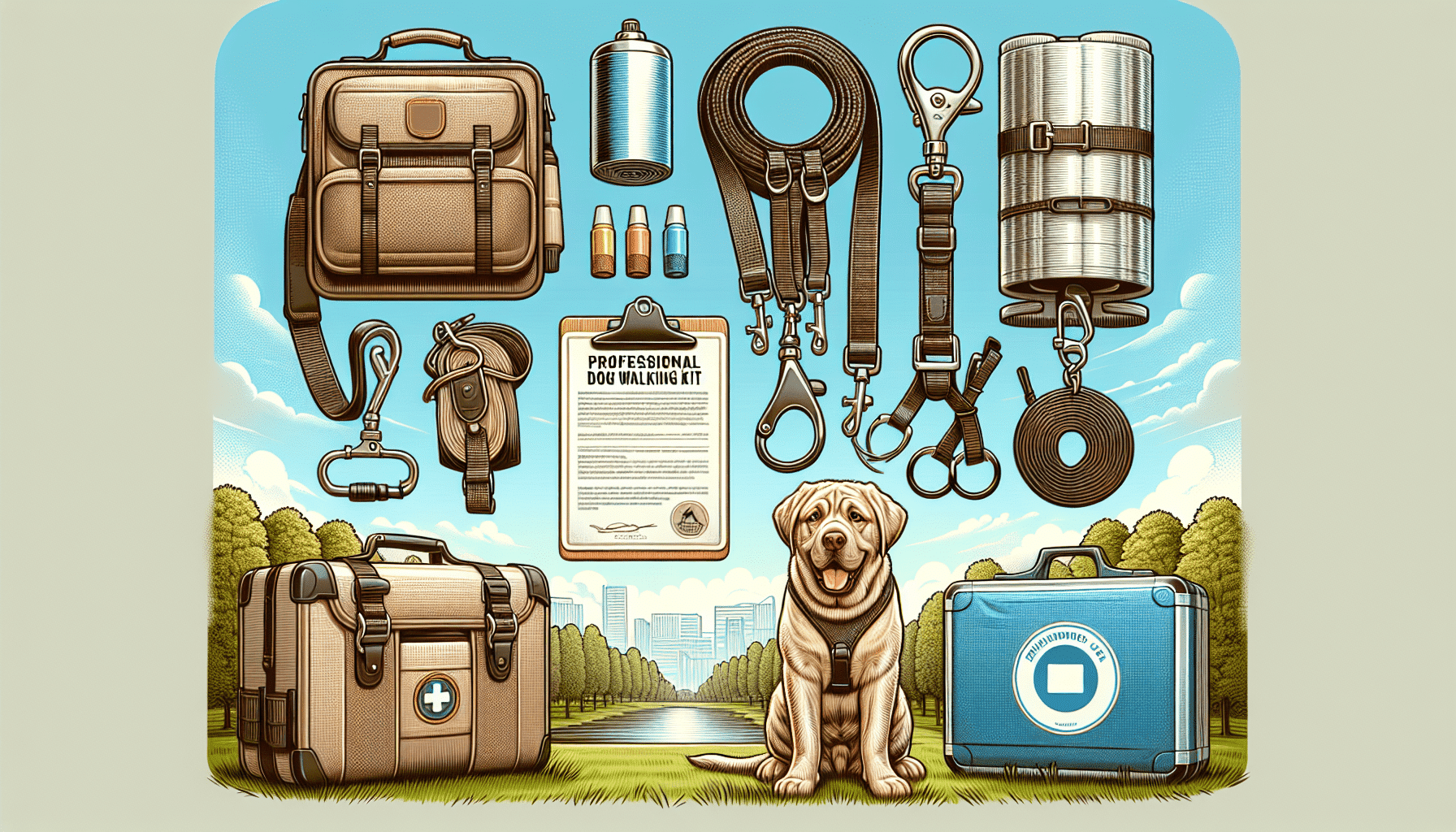Are you an avid dog lover looking to turn your passion into a profitable venture? Look no further than starting your own dog walking business! This article will provide you with all the information you need to embark on this exciting journey. From the basics of starting a business to helpful tips on how to establish a successful dog walking service, we've got you covered. So grab your leash and get ready to take the first steps towards building a rewarding and fulfilling career as a professional dog walker.
Researching the Dog Walking Industry
Understanding the demand for dog walking services
Before starting a dog walking business, it is crucial to research and understand the demand for such services in your area. Take into account factors such as population density, pet ownership rates, and the lifestyles of potential clients. Determine whether there is a need for dog walking services by conducting surveys, speaking to local pet owners, or analyzing data from pet-related organizations.
Identifying your target market
To effectively target your services and marketing efforts, you need to identify your ideal clients. Consider factors such as age, location, and lifestyle when determining your target market. For example, busy professionals who work long hours may require regular dog walking services, while elderly or disabled individuals may need assistance with their pets. By understanding your target market, you can tailor your services to meet their specific needs.
Analyzing the competition
To stand out in an industry, it is essential to research and analyze your competition. Identify other dog walking businesses in your area and study their services, prices, and marketing strategies. Understanding what sets your competitors apart can help you differentiate your business and find a unique selling proposition. Look for gaps or areas of improvement in the market that you can capitalize on to attract clients.
Determining the legal requirements
It is crucial to comply with legal requirements when starting a dog walking business. Research the regulations and permits needed in your area to operate legally. This may include obtaining business licenses, liability insurance, and adhering to local zoning laws. Additionally, familiarize yourself with specific regulations related to handling and transporting animals. Complying with legal requirements not only ensures your business operates within the law but also instills trust and credibility with potential clients.
Creating a Business Plan
Defining your business goals and objectives
A well-defined business plan is essential for the success of your dog walking business. Clearly articulate your goals and objectives, both short-term and long-term. Are you aspiring to be the go-to dog walking service in your area or looking to expand to multiple locations? Your goals will guide your decision-making and help you stay focused on achieving your desired outcomes.
Outlining your services and pricing
Clearly outline the services you will offer as a dog walker. Will you provide group walks, individual walks, or both? Determine how long each walk will last and whether you will offer additional services such as pet sitting or grooming. Additionally, establish your pricing structure based on factors such as your operating costs, market rates, and the value you provide. Consider offering different packages or discounts to attract new clients and retain existing ones.
Establishing a marketing strategy
Developing a comprehensive marketing strategy is vital for attracting clients to your dog walking business. Determine the best channels to reach your target market, such as online platforms, local advertising, or word-of-mouth referrals. Leverage social media and create a professional website to showcase your services and build credibility. Invest in professional photography to showcase happy dogs and satisfied clients. Utilize online directories, local community forums, and collaborations with other pet-related businesses to increase your visibility.
Setting financial projections
Creating financial projections ensures you have a clear understanding of your business's revenue and expenses. Estimate your monthly and annual revenue based on your pricing, the number of clients you anticipate, and your target market size. Consider your operating costs, including insurance, supplies, and marketing expenses. This information will help you determine how many walks you need to cover your expenses and achieve your desired income. Regularly review and adjust your financial projections as your business grows to ensure you stay on track.

This image is property of images.unsplash.com.
Acquiring the Necessary Skills and Certifications
Learning about dog behavior and handling
To provide quality dog walking services, it is essential to have a deep understanding of dog behavior and handling techniques. Educate yourself on dog body language, handling methods, and basic obedience training. Familiarize yourself with common health issues that dogs may experience and how to address them. Understanding different breeds and their specific needs will also help you tailor your services to each dog's requirements.
Obtaining certifications in dog training or pet first aid
While not strictly necessary, obtaining certifications in dog training or pet first aid can set you apart from competitors and enhance your credibility. Consider enrolling in courses or workshops that provide training in these areas. Certification in pet first aid can help you handle emergencies while on walks, ensuring the safety and well-being of the dogs under your care.
Developing strong communication skills
Effective communication is key to building trust and rapport with both dogs and their owners. Develop strong communication skills to understand and interpret clients' instructions and preferences accurately. Additionally, learn to communicate with dogs through consistent and positive reinforcement methods. Clear communication will help you address any concerns or issues promptly, ensuring both the dogs and their owners are satisfied with your services.
Gaining experience with different dog breeds
Each dog breed has unique characteristics and requirements. To provide the best possible care, gain experience working with a variety of dog breeds. This will help you understand their specific needs, exercise preferences, and potential behavior challenges. Consider volunteering at local animal shelters or fostering dogs to gain practical experience and expand your knowledge of different breeds.
Setting up Your Business
Choosing a business name and legal structure
Selecting a catchy and memorable business name is crucial for branding and marketing purposes. Choose a name that reflects your professionalism and the services you provide. Once you have chosen a name, decide on the legal structure of your business, such as a sole proprietorship, partnership, or limited liability company (LLC). Consult with a legal professional or a business advisor to determine the best structure for your specific circumstances.
Registering your business with the appropriate authorities
To operate legally, register your business with the necessary authorities. This typically involves registering your business name with the local government and obtaining a tax identification number. Research the specific requirements in your area to ensure compliance with all necessary registration processes.
Obtaining necessary permits and insurance
Depending on your location, you may need to obtain permits or licenses to operate your dog walking business legally. Research the requirements in your area and complete any necessary applications or inspections. Additionally, invest in liability insurance to protect yourself, your clients, and their pets in case of any accidents or injuries during walks. Insurance provides peace of mind and demonstrates your commitment to the well-being of the dogs under your care.
Creating a professional website and branding materials
A professional website and branding materials help establish your credibility and attract potential clients. Invest in a well-designed website that showcases your services, rates, and contact information. Include high-quality photos of happy dogs and positive testimonials from satisfied clients. Develop branding materials such as a logo, business cards, and brochures that maintain a consistent visual identity. These materials will help you leave a lasting impression and increase your chances of converting inquiries into clients.

This image is property of images.unsplash.com.
Building a Client Base
Marketing your services to potential clients
To build a client base, proactively market your dog walking services to potential clients. Network within your community and attend local events related to pets or pet care. Share business cards and brochures with pet owners you encounter. Consider hosting a launch event or participating in community projects to generate interest and get your name out there. Leverage online platforms such as classified ads, local directories, and social media to reach a broader audience and attract new clients.
Utilizing online platforms and social media for promotion
In today's digital age, having an online presence is crucial for business success. Create social media accounts for your dog walking business and regularly post engaging content. Share photos and videos of happy dogs on walks and promote any special offers or promotions. Engage with followers by responding to comments and messages promptly. Make use of online platforms like Google My Business, Yelp, and pet-specific directories to maximize your online visibility and reach potential clients searching for dog walking services.
Networking with local pet-related businesses
Building relationships with local pet-related businesses can help generate referrals and expand your client base. Reach out to local veterinarians, pet stores, groomers, and trainers to establish mutually beneficial partnerships. Offer to distribute their promotional materials in exchange for them referring their clients to your services. Attending pet-related events or joining industry associations is also an excellent way to connect with fellow professionals and expand your network.
Offering special promotions or discounts
To attract new clients and encourage repeat business, consider offering special promotions or discounts. This could include discounted rates for first-time clients, referral incentives, or loyalty programs. Special promotions can generate buzz and motivate potential clients to try your services. Continually assess your business's financial performance to ensure any discounts or promotions align with your long-term profitability goals.
Developing Policies and Procedures
Establishing clear guidelines for dog walking sessions
Developing clear guidelines for your dog walking sessions ensures consistency and sets expectations for both you and your clients. Establish the maximum number of dogs you will walk at once, the duration of each walk, and any specific requirements or limitations. Clearly communicate these guidelines to your clients before starting your services to avoid any misunderstandings or conflicts.
Creating contracts and liability waivers
Protect your business and clients by creating well-drafted contracts and liability waivers. Contracts should outline the terms of your services, pricing, cancellation policies, and any additional fees or charges. Liability waivers ensure that clients understand and accept responsibility for any risks associated with their dogs being walked. Consult with a legal professional to ensure your contracts and waivers provide adequate protection for your business and its clients.
Implementing safety protocols for handling dogs
Safety should always be a top priority when handling dogs during walks. Implement safety protocols to minimize the risk of accidents or injuries. This may include using secure leashes and harnesses, being mindful of potential hazards, and practicing proper leash and control techniques. Regularly assess and update your safety protocols to stay informed about best practices and industry standards.
Setting boundaries for pet owner interactions
Establishing clear boundaries for pet owner interactions helps maintain a professional and respectful relationship. Clearly communicate your availability, preferred modes of communication, and response times to avoid any confusion or excessive demands. Encourage open and transparent communication, but let clients know when and how you can be contacted, both during and outside of dog walking hours. Setting boundaries ensures that both you and your clients understand and respect each other's expectations.
This image is property of images.unsplash.com.
Providing Quality Dog Walking Services
Creating a personalized approach to each dog's needs
Dogs have individual needs and preferences, so it is important to create a personalized approach for each dog you walk. Take the time to understand each dog's temperament, exercise requirements, and any specific instructions from the pet owner. Tailor your walks to accommodate their needs, whether it's a shorter stroll for a senior dog or an energy-burning play session for an active breed. Personalizing your services ensures that each dog receives the care and attention they deserve.
Building trust and rapport with the dogs and their owners
Building trust and rapport is critical to the success of your dog walking business. Establish a positive and trusting relationship with each dog through regular and consistent interaction. This will not only make the dogs more comfortable during walks but also instill confidence in their owners. Communicate openly and regularly with pet owners, providing updates and addressing any concerns promptly. Building trust with both the dogs and their owners will lead to long-term client relationships and positive word-of-mouth referrals.
Ensuring the safety and well-being of the dogs during walks
The safety and well-being of the dogs under your care should be your top priority during walks. Ensure that dogs are walked in safe environments, away from busy roads or other potential hazards. Use appropriate equipment, such as sturdy leashes, harnesses, and ID tags, to minimize the risk of escape or injury. Watch for any signs of discomfort or distress in dogs and learn the proper response to address such situations. By prioritizing safety, you will earn the trust and confidence of pet owners, setting your business apart from competitors.
Maintaining open and transparent communication with pet owners
Regular and open communication with pet owners is key to providing quality dog walking services. Keep pet owners informed about their dogs' walks, including the duration, any incidents or unusual behaviors observed, and any necessary follow-up. Update pet owners on any changes to scheduling or availability, promptly address any concerns or questions, and provide a reliable point of contact. Maintaining open and transparent communication builds trust, reassures pet owners, and enhances the overall client experience.
Expanding and Scaling Your Business
Hiring additional dog walkers or employees
As your dog walking business grows, you may need to hire additional dog walkers or employees to meet the demand for your services. Carefully select individuals who share your passion for dogs and provide thorough training on your service standards and protocols. Ensure that your new hires understand your business's values and can maintain the same level of care and professionalism you provide. With a trustworthy and capable team, you can expand your capacity to serve more clients and increase your business's revenue.
Adding supplementary pet services to your offerings
Consider expanding your service offerings beyond dog walking to increase revenue and cater to a broader range of pet owners. This could include pet sitting, pet transportation, or even training classes. Assess the needs and preferences of your existing clients to identify additional services they may value. Offering supplementary pet services not only generates additional income but also increases customer loyalty by providing a comprehensive solution for their pet care needs.
Expanding your service area or opening new locations
If your dog walking business experiences significant success, you may consider expanding its geographic reach or opening new locations. Conduct market research to identify areas with high demand for dog walking services that are currently underserved. Evaluate the feasibility of expanding your business by analyzing factors such as market size, competition, and logistical considerations. Expand strategically, ensuring that you can maintain the same level of quality and customer satisfaction across your expanded service area or new locations.
Investing in marketing and advertising to reach a larger audience
As you expand your dog walking business, investing in marketing and advertising becomes increasingly important to reach a larger audience. Allocate resources for targeted marketing campaigns, both online and offline, to raise awareness of your services and generate new leads. Consider using platforms such as search engine advertising, social media promotions, and sponsored events to expand your reach and attract potential clients. Track the effectiveness of your marketing efforts and adjust your strategies as needed to maximize return on investment.

Managing Finances and Bookkeeping
Setting up a system for tracking income and expenses
Effective financial management is essential for the long-term success of your dog walking business. Set up a system, such as accounting software or spreadsheets, to track your income and expenses accurately. Record all revenue streams, including dog walking fees, additional services, and any merchandise you sell. Keep thorough records of your expenses, such as insurance premiums, supplies, and advertising costs. Regularly review your financial statements to assess your business's financial health and make informed decisions.
Monitoring cash flow and budgeting appropriately
Monitoring your cash flow and budgeting appropriately will help you maintain a stable financial position. Track your incoming and outgoing cash on a regular basis to ensure you have enough liquidity to cover expenses, pay employees, and invest in business growth. Create a budget to allocate funds for different purposes, such as marketing, employee wages, and supplies. Continually assess and adjust your budget based on seasonal variations and changes in your business's needs.
Sourcing affordable suppliers for pet-related supplies
To maximize your profit margins, it is essential to source affordable suppliers for pet-related supplies. Research and identify suppliers who offer competitive prices without compromising on the quality of the products. Consider purchasing in bulk to take advantage of bulk-buying discounts. Regularly compare prices and negotiate with suppliers to ensure you are getting the best possible deals. Balancing affordability with the quality of supplies will help you manage your expenses and improve your bottom line.
Paying taxes and understanding financial obligations
As a business owner, it is crucial to understand your financial obligations, including taxes. Research the tax requirements for your dog walking business and consult with a tax professional to ensure you comply with all applicable regulations. Familiarize yourself with deadlines for filing tax returns and paying any necessary taxes. Keep accurate and organized records of your income, expenses, and relevant receipts to facilitate the preparation of your tax documents. Compliance with tax laws and regulations is not only a legal requirement but also contributes to your business's financial stability and reputation.
Continuing Education and Professional Development
Staying up-to-date with industry trends and best practices
The dog walking industry is constantly evolving, with new trends and best practices emerging. Stay up-to-date with industry trends by regularly reading industry publications, blogs, and newsletters. Follow thought leaders and experts in the field on social media to stay informed about the latest developments. Attend industry conferences and events to network with other professionals and gain insights into emerging trends and innovative approaches to dog walking.
Attending workshops and conferences for pet care professionals
Attending workshops and conferences specifically designed for pet care professionals can provide valuable knowledge and networking opportunities. Look for opportunities to enhance your skills and knowledge in areas such as dog behavior, training techniques, and business management. These events often feature renowned speakers and trainers who can share valuable insights and practical strategies. By continuously investing in your professional development, you can deliver exceptional services and position yourself as a trusted expert in the dog walking industry.
Taking additional courses or certifications to enhance skills
Continuing to expand your skill set through additional courses or certifications demonstrates your commitment to providing quality services. Explore courses that focus on topics such as dog behavior, positive reinforcement training methods, or business management skills. Certifications offered by reputable organizations can also add credibility to your credentials. Evaluate each opportunity based on its relevance to your business goals, the reputation of the course provider, and the potential benefits it can bring you and your clients.
Networking and collaborating with other dog walkers or business owners
Networking and collaborating with other dog walkers or business owners in your industry can be mutually beneficial. Attend industry-specific networking events or join local business organizations to connect with like-minded professionals. Share tips, experiences, and best practices with others in the field to learn and grow together. Collaborate on joint marketing projects or partnerships to expand your network and increase your collective visibility. By building relationships within the industry, you can access a wealth of knowledge, resources, and potential business opportunities.
In conclusion, starting a dog walking business requires thorough research, careful planning, and a commitment to continuous learning and improvement. By understanding the demand for dog walking services, identifying your target market, and analyzing the competition, you can position your business for success. Creating a comprehensive business plan, acquiring the necessary skills and certifications, and setting up your business in compliance with legal requirements will establish a solid foundation. Building a client base through effective marketing, developing clear policies and procedures, and providing quality services will help you earn a reputation as a trusted dog walker. As your business grows, managing finances responsibly, expanding strategically, and investing in your professional development will facilitate long-term success. With passion, dedication, and a focus on delivering outstanding care, you can thrive in the dog walking industry and enjoy the fulfillment of helping dogs live their best lives.



